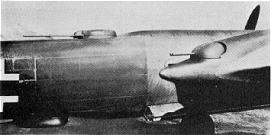Good, as they say, God...
...Considering the wallowing performance of high-altitude fighters being barely able to hit 40,000 feet, I thought (wholly independently) of a Vickers Victory with a ventral twin 20-mm remote-controlled turret. As an alternative and post-attack mission, hunting Luftwaffe high-altitude fighters trying to intercept the returnees. A bastard to dive with, but very nasty if it got near you. The original design had a tail-turret.
...Considering the wallowing performance of high-altitude fighters being barely able to hit 40,000 feet, I thought (wholly independently) of a Vickers Victory with a ventral twin 20-mm remote-controlled turret. As an alternative and post-attack mission, hunting Luftwaffe high-altitude fighters trying to intercept the returnees. A bastard to dive with, but very nasty if it got near you. The original design had a tail-turret.

